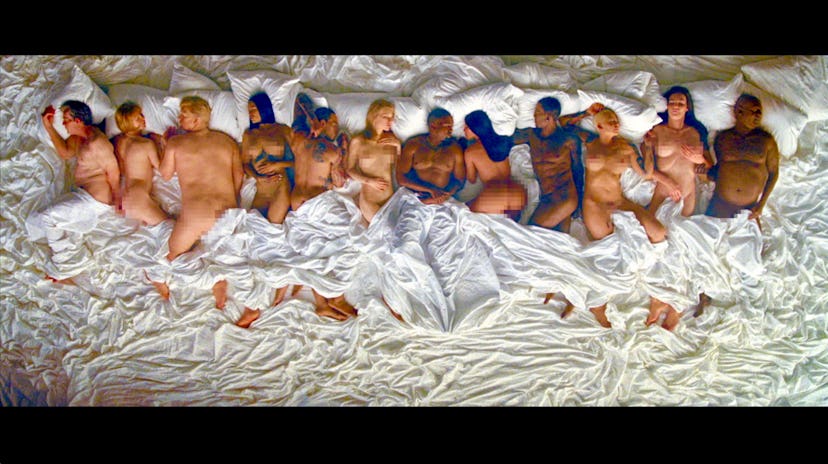On Kanye West’s “Famous” Video, From the Artist Who Inspired It

The remarkable debut this weekend of Kanye West’s video, “Famous,” was a feat of magic. It held its audience in suspension over a tableau that was disturbingly familiar, rapturously beautiful, and frighteningly uncanny.
The strange collision of worlds is the hallmark of our society in rapid transition. To this we can credit the cynicism of the now academic high-low compression in the visual arts, and the endless demonstrations by elitists and anti-intellectuals alike, each camp utterly convinced of its firm grasp of history’s inevitable trajectory.
Occasionally, however, the perpetual static that forms public opinion clears, and for a brief moment a deep and intimate understanding is reached, unimpeded by the ever-present difficulties of translation. The recent presentation of Kanye West’s video, “Famous,” based to a large extent on my 2008 painting, “Sleep,” underscored one of these precious moments.
It began with a random phone call: “Kanye West is trying to get in touch with Vincent Desiderio. It is extremely important that he return our call.” After a series of missed calls and frantic text messaging I came to learn that I was being invited to fly out to Los Angeles the next morning to meet the acclaimed artist, and that Kanye, “being a tremendous fan” of my work—I’m using quotes, because one hears that phrase so often in the art world that it might as well mean, “I have no idea who you are and please don’t call me out on this”—wanted me to be present at an event the Forum in L.A. No other information was given.
Vincent Desiderio's “Sleep,” 2008. © Vincent Desiderio, courtesy Marlborough Gallery.
When I arrived the next day, I was told not to go to the hotel but instead directly to the Forum. The mystery redoubled as I was lead through a system of corridors and security checks to a room whose door was streaked with wild Abstract Expressionist marks. Inside was a small gathering of men and women seated around a laptop. Kanye stood up and greeted me warmly. We spoke about his new album, “The Life of Pablo,” and about a particular quote by Edgar Degas, about how a painting should be constructed “like the perfect crime.” I ventured that the Pablo referred to in the title was a dual reference to Pablo Picasso and Pablo Escobar. Kanye smiled and said, “St. Paul, too.” His eyes glistened. We were on the same page.
“Would you like to see something we have been working on?” he asked.
I sat down in front of the computer screen as the play button was pushed. Within seconds, the disturbingly familiar faces of a range of celebrities became clear. What was not clear was what in fact they were doing sleeping in the same bed. Had there been some agreement to pose together naked? That aside, why was every impulse to ridicule these people, some of whom (I won’t name names) made my skin crawl, being tempered by a rising sense of empathy? Slumbering gods, they were, but also like babies or small children at the height of vulnerability.
Then an even stranger feeling overtook me. I began to recognize that the naked bodies floating past the camera lens were in positions identical to the figures in my painting, “Sleep.” Could Kanye have seen my painting? There were so many similarities. Yes, it was my painting. It had been sampled, or “spliced,” into a new format and taken to a brilliant and daring extreme!
As I looked around the room at the smiling faces, it became apparent that, unbeknownst to me, a remarkable collaboration had occurred, one that brought together artistic expressions that, at least on the surface of it all, couldn’t seem further apart. I felt as if I had been presented with the most extraordinary gift: Kanye and his crew had spent the past months producing a video of tremendous power and beauty, and at its core was a painting. My painting.
But how could it be that Kanye could make a parallel version of “Sleep,” while charging it with the same kind of intrinsic strangeness that haunted my thoughts as I made the original painting. Stranger still was that he knew nothing of a video I have wanted to make as a site-specific installation on the ceiling of Grand Central Station. It would have involved a frame projection of figures sleeping in real time, like slumbering gods, around the green zodiac vault. We concluded that our minds were clearly operating on the same wavelength, albeit from different transmitters.
What was demonstrated was the power of the artistic imagination to transcend categorical expectations, and the fluidity of the transfer of codes deeply embedded within the apparatus of our preferred mediums. Kanye West’s video demonstrates how art speaks the language of art, how visual codes people the artistic imagination, enlivening the matrix of possibilities that are always and everywhere about us, but barely perceptible to those who focus only on the surface.
All the Famous Faces in Kanye West’s “Famous”
Still from “Famous.”
Kanye West and Kim Kardashian in “Famous.”
Donald Trump in “Famous.”
Taylor Swift in “Famous.”
Kanye West and Kim Kardashian in “Famous.”
Amber Rose in “Famous.”
Anna Wintour in “Famous.”
Chris Brown and Rihanna in “Famous.”
Caitlyn Jenner in “Famous.”
Kanye West in “Famous.”
Bill Cosby in “Famous.”
Bill Clinton in “Famous.”
Still from “Famous.”